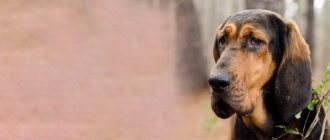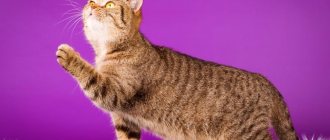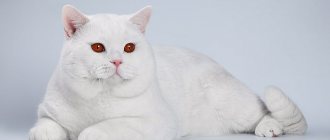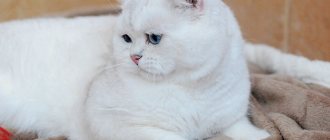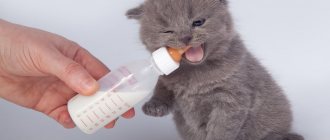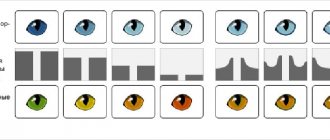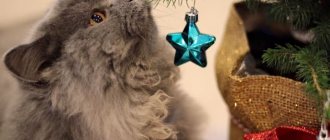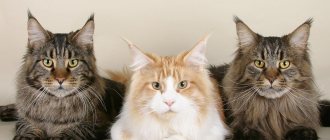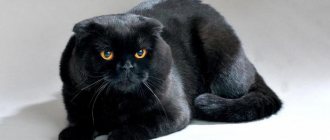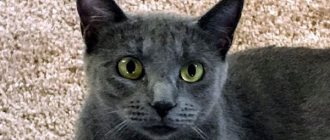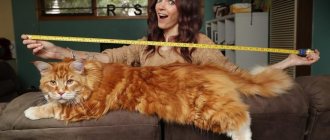What does a British cat look like?
It is quite easy to distinguish a British cat from an ordinary cat. It is always a “powerful”, squat and harmonious animal with rounded shapes. The chest of a large British cat looks wide, and the shoulders and back are massively dense, which is why the pet sometimes seems fat. The British cat has a smaller body shape, but with similar features.
Fold-eared Briton - reality or myth>>
Mating, pregnancy, birth of British breed cats >>
Representatives of the breed can also be identified by their relatively muscular and short legs, which have a slightly rounded shape. The tail of British cats resembles a conical shape with a rounded tip.
The most easily recognizable characteristics of the British are their expressive face and plush coat.
The face of a British cat always has well-developed cheeks, which are often called sideburns. The general description of the facial expression of British cats includes a benevolent, friendly look and a natural “smile” like the Cheshire Cat from “Alice in Wonderland.” The main advantage of these pets is their velvet-plush fur, in which your hands sink. Regardless of whether the Briton is a shorthaired or longhaired dog, his coat should have a springy, fine texture and a fluffy undercoat. Types of British >>
In order to choose the right purebred, elite Briton, we recommend that you study in advance the distinctive features of the breed, its standard and seek help from a felinological organization that will provide you with the addresses of worthy nurseries.
Why does a British cat have a hanging belly?
Many owners of British breed cats often notice a saggy belly on their pet. And, naturally, they ask the question: “Isn’t this dangerous for health?” So, this is not a reason to panic at all. This is how British cat physiology works, and not only that! Even mongrel cats often have droopy bellies, just in a less pronounced form.
A fat tail is not a flaw in the exterior; experienced experts at exhibitions do not even pay attention to it. The only period when a British cat's belly disappears is during feeding, after which it appears again. Therefore, in no case should you cut down on the animal’s nutritional intake, since a thin British cat has a much larger fat fold. The British dog must look “appetizing” so that all its rounded shapes are clearly expressed, and then the pouch on the belly will only decorate the pet.
How much should an adult cat weigh: table by age and breed
As noted above, weight gain continues until approximately 1.5-2 years. From this moment on, it stabilizes, so the owner can simply hold it.
The table below shows the weight norms for male cats by age and breed.
| Breed | Weight, kg) | |
| Males from 1.5 to 8 years | Females from 1.5 to 8 years | |
| British | 5-8 | 3-6 |
| Scottish | 4-7 | 3-5 |
| Maine Coon | 8-12 | 4,6-7,5 |
| Don Sphynx | 5-7 | 3,5-4 |
| Canadian Sphynx | 5-7 | 3,5-4 |
| Persian | 4-6,2 | 3-5 |
| Siamese | 4-5,6 | 3-4 |
| Siberian | 6-9 | 3,5-7 |
| Russian blue | 3,5-5,8 | 3-4 |
| Abyssinian | 4-7,5 | 3-4,5 |
| Ragdoll | 7-10 | 4-6 |
| Exotic | 4-6,2 | 3-5 |
| Bengal | 5-7 | 3,5-4,5 |
When the animal reaches 8 years of age, it is classified as elderly. The processes in his body slow down. Most of what you eat is stored as fat, and due to reduced activity, muscle mass noticeably decreases. As a result, a pet that meets the above standards may look much more well-fed. This is due to the fact that fat is always lighter than muscle. This feature of the body once again confirms the advisability of a visual inspection.
It is also worth mentioning the relationship with castration and sterilization. After surgery, animals often weigh more than normal. The reasons here are the same as with aging: a slowdown in metabolism and a decrease in usual activity.
Characteristics of British cats
The British Shorthair cat is valued not only for its cuteness and intelligent, kind look. This “fur” miracle has a calm temperament and good health.
The British are great for business people who spend most of their lives at work.
Pets love to retire for long periods of time so that no one disturbs their sweet sleep. However, this characteristic of a cat being like a teddy bear does not mean that it can be treated like a toy. The Briton will never allow his dignity to be humiliated.
Character and habits of British cats >>
Many owners complain that cats of this breed are unsociable and rarely allow them to be cuddled. But this does not mean that they do not show their love and affection for their owner. It's just that British cats are more restrained in expressing their feelings and are quite self-sufficient, unlike other breeds.
But information about the aristocratic behavior of a Briton from an early age pleases any “cat person.” After all, these pets are very clean and will never allow themselves to relieve themselves in the wrong place. In addition, British cats love to take care of their appearance on their own - they can spend half of their active time on licking and washing themselves in order to always look respectable and radiate charm and charm!
Tips for maintaining normal weight
To keep a British cat's weight within normal limits, owners need to maintain a balanced diet:
- add a small percentage of cereals and vegetables to dry and soft food;
- add boiled vegetables to the food (various varieties of cabbage, beets);
- meat and fish should only be lean, they should be included in the menu daily;
- Among the cereal products, it is best to give your cat oatmeal, millet, and rice;
- You need to cook porridge for your pet in water, without adding sugar and salt.
A kitten is taught to eat cereals and vegetables from an early age. The diet of an adult British cat should consist of 10–15% vegetables and cereals, 85–90% meat and fish.
Also, we must not forget about regular physical activity. To prevent a cat from developing obesity, the owner must engage it in active games every day.
High-quality and balanced nutrition, an abundance of vitamins and nutrients, an active lifestyle - these are the main factors for the full development of a British pet.
The owner should weigh the kitten at the same time every day in order to notice weight deviations in time. If the development of the “British” does not correspond to his age, then there is no need to hesitate in going to the veterinarian.
British breed standard
Do not forget that no matter how attractive a cat may be, in order to participate in the exhibition he must meet a certain standard.
The standard for each part of the body of a British cat is prescribed taking into account the requirements of the felinological organization in a special document.
WCF standard for British:
- Body. Squat, strong. Medium or large size.
- Head. Rounded, with a wide skull and short neck.
- Ears. Medium size, widely set, rounded.
- Nose. Small size, straight. On the line with the forehead it stands out with a small depression.
- Eyes. Moderately large, widely spaced. Any clearly defined color.
- Tail. Be sure to be short, fluffy at the base and rounded at the tip.
- Wool. Dense, thick, equal length. Has a well developed undercoat.
Other systems may have some differences in the standard, but generally are not very different from a WCF system.
If there are defects such as an elongated tail, thin paws, a body that is too short or a close-fitting coat texture, a British cat may be disqualified from the show. Therefore, to evaluate your pet, visit a special examination before the exhibition, where a specialist will explain in detail the pros and cons of the animal in accordance with the breed.
What are the dangers of obesity?
You can tell that a cat is obese by its sagging belly. Because the fat layer is too thick, the costal and vertebral bones cannot be felt. An obese animal moves slowly and ignores active activities.
ATTENTION! An obese cat needs to be examined at a veterinary clinic for prevention, as there is a high probability of developing diseases of the heart and vascular system, as well as inflammation of the joints.
Excess weight greatly affects the health of a British pet. The most common pathologies:
- increased blood pressure, development of atherosclerosis;
- lethargy, powerlessness, drowsiness;
- hormonal disbalance;
- blurred vision due to increased intraocular pressure;
- development of diabetes;
- the appearance of gout, osteoarthritis;
- disruption of the digestive tract;
- hard breath;
- thirst;
- deterioration of metabolism;
- weakening of the immune system.
What kind of hair do British cats have?
Special attention should be paid to British wool. Thanks to the harsh living conditions in the past, these animals have acquired an excellent coat with a very dense and thick undercoat. Despite the fact that the structure of the wool itself is thin, it feels quite elastic and soft to the touch. Therefore, representatives of this breed are often called plush. In addition, the coat of British cats is distinguished by beautiful, shiny colors. British cat care and maintenance >>
At the moment, there are about 60 colors that the British have. It can be any solid color, smoky, tortoiseshell, tabby, chinchilla, bicolor or colorpoint. The most common among them are solid blue, as well as two-color tabby and chinchilla.
Important! The British Shorthair's coat should be the same length all over the body. As a rule, it does not exceed 2.4 cm.
A healthy British cat never develops tufts of fur, so he can easily take care of his coat on his own.
Why is it important to control your pet's weight?
Caring owners must keep a diary of their kittens' weight from the very first days of their life. This allows you to monitor the development of your pet. It is very difficult to control based on visual parameters: that is why the measurement is based on weight. It is recommended to have accurate electronic scales in the house and weigh babies every day in the first weeks of life, and later - at least once a week. The weight of a newborn baby must be at least 60 grams, otherwise you should immediately contact a veterinarian. Such a baby must be fed with special care in the future.
What kind of eyes do the British have?
Against the backdrop of the expressive face of the British cat, the large and round eyes really stand out. They are always set wide apart and have a clean, bright look.
At 4 months, Britons' eye color usually begins to change depending on their coat color. Only an experienced specialist can tell you the final color result at this age. For example, a cat can become blue-eyed only if its coat is white.
Another feature of snow-white cats is the ability to have eyes of two colors: blue and yellow, gold and copper, blue and copper. Cats with silver colors and tabby patterns usually have green eyes. All other color variations of coat colors have mostly swamp eyes in childhood, gradually acquiring an amber, copper tint.
Note! The outline of the iris of the eyes of British cats should correspond to the general tone. A darker outline is considered a defect.
When to adopt a kitten
Only a mother cat can provide proper care for newborn British kittens; this is possible in a nursery where kittens are not separated from their mother until they reach the age of 12 weeks. This approach allows:
- gain the kitten the required body weight - 1.5-1.7 kg by 3 months;
- receive complementary foods in the required amount and with the required regularity;
- receive breast milk as the main diet;
- learn self-care skills from your mother;
- undergo vaccination and anthelmintic treatment.
British kittens should be fed 4 times a day with natural food. Up to three months, there is a high probability of injury for kittens due to weakness of the skeletal system, and complications after vaccinations are also possible.
Therefore, reputable nurseries give away kittens that have reached the age of three months. If the babies are over 2 months old, caring for British kittens is not difficult, although it requires free time. After all, pets should be fed 4 times a day with natural food, preparing fresh meals daily, including the necessary set of vitamins, proteins, fats, carbohydrates, minerals, and acids. A complete switch to dry food at this age is fraught with complications of the digestive system for the kitten. The kitten's weight should double in a month. At three months of age, the kitten is transferred to two meals a day.
It is advisable to give away British kittens at three months of age.
